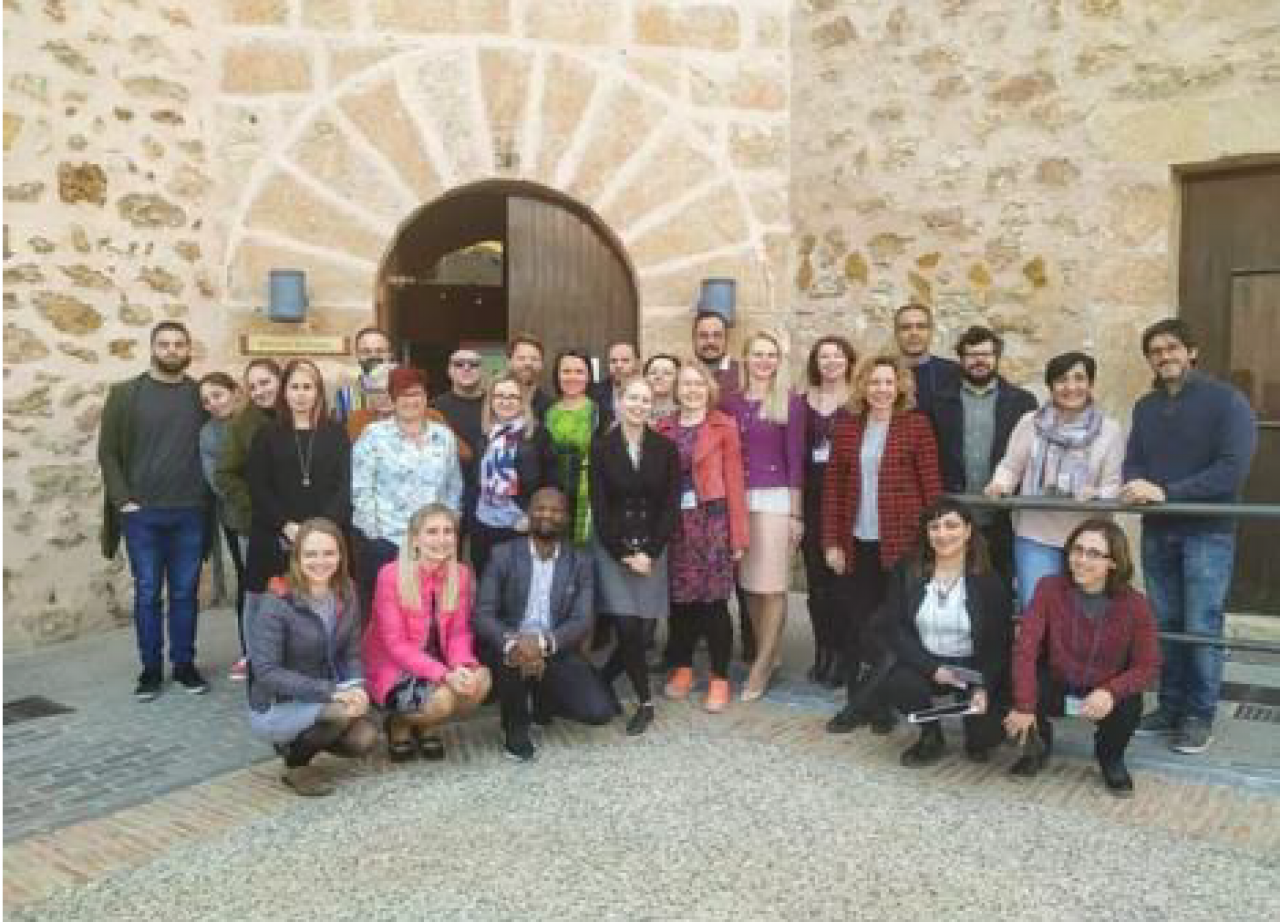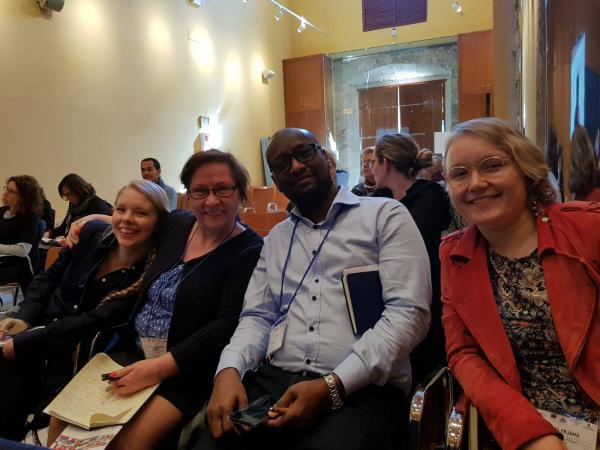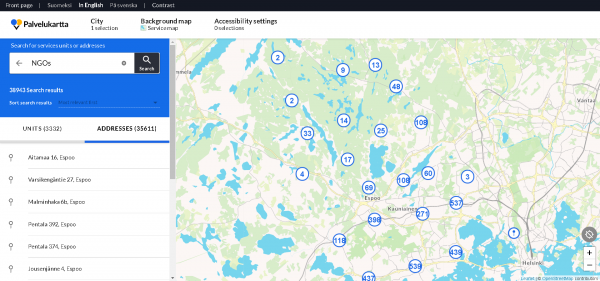
On a sunny day in February 2019, we arrived at Santa Pola from the Espoo Municipality as members of the ACTive NGOs project. Instead of the cold and rainy weather in Finland, we immediately noticed the stunning scenery and the blue beach in Santa Pola. The Santa Pola members of ACTive NGOs projects were extremely friendly, helpful and pleasant.
We attended meetings and workshops to discuss about transfer plans at the local level. It was a crucial and valuable opportunity for us to learn from other cities in developing and improving cooperation models between NGOs and municipalities.
“The idea of co-development has been strengthened. These actively involved organisations and departments have realised the importance of learning by doing together” – says Maria Tiilikkala, NGO cooperation coordinator, City of Espoo.
A Transnational Meeting to address the challenges and find creative initiatives
In the Santa Pola workshop, we were impressed by the experiences and good practices among our partners across Europe - Riga (LV), Syracuse (IT), Santa Pola (ES), Dubrovnik (HR), Brighton and Hove (UK) and our city, Espoo (FI). Under the leadership of the lead expert – Levente Polyak, many issues of NGO activities were addressed and discussed to find the solutions.
In Espoo, we had challenges in mapping, network building, communication between municipality and the NGOs. Although almost all NGOs and municipal workers are very active and play a key role in the civil society, there is lack of information on NGOs in Espoo. Among around 3000 NGOs, many organisations do not advertise their activities or get involved with the municipality. Many NGOs with immigrant background are often small, unofficial and voluntary-based. They are often disconnected from each other and the municipality that makes it complicated to build trust between different stakeholders. Due to the spatial fragmentation of the city’s urban fabric, more knowledge of the whole local NGO scene is needed.
Therefore, the maps of the Los Madriles project (https://losmadriles.org/) that was presented in Santa Pola made a great impression on us. The message of Los Madriles was amplified by Santa Pola, home to an active civil society that provided a great backdrop to discussing mapping methodologies. It was a wonderful idea to combine the physical map with a digital one: the graphic features of the map and its digital accessibility make Los Madriles very user-friendly.
“In the modern setting of rapidly changing needs it is important to adjust to the society. NGOs have to exist in constant development and be engaged and connected with their target groups. From the Transnational Meeting in Santa Pola, I find the idea of having digital and physical communication balanced very reasonable and current. The Los Madriles project inspired both Santa Pola and Espoo. It is pleasing to see how strategy is merged into a physical manifestation” – says Artem Kousti, ULG member, representative of the Finnish Association of Russian Speaking Organisations (FARO).

Transnational Meeting of ACTive NGOs project in Santa Pola, February 2019
How to bring city-to-city learning from across Europe?
Learning new ideas based on an URBACT Good Practice is the starting point to improve the Espoo Municipality’s capacities within the ACTive NGOs project. The valuable idea of developing a map of NGO services was discussed in the Espoo URBACT Local Group (ULG) meeting, in March 2019. “Currently, the City of Espoo announces and promotes its services mainly through the Internet and magazines that are sent to homes. Using an online map similar to Los Madriles could help us in implementing the good practice of Riga. The map would allow the residents in Espoo to have a better idea of what is happening in their own hometown. ACTive NGOs will help to push this idea forward,” says Terhi Pippuri, Senior Planning Officer in the Espoo Municipality.
“In the ULG meeting, we also realized that we are already collecting similar information about the work of associations digitally on Uusimaalaiset.fi, but without the map form. In the capital region of Finland, we already have a digital map of public services. It is called Service Map (Palvelukartta.fi). Therefore, at the ULG meeting we started discussing if it was possible to bring information about NGOs from Uusimaalaiset.fi to the Service Map through automatisation between two different technical systems. In other words, would it be possible that when associations publish their information in Uusimaalaiset.fi, it would be automatically published also in the map service?” remembers Ulla-Kaisa Pihlaja, Planning Officer of Civic Action, EJY Ry.
The strengths and challenges of the new Service Map development in Espoo
According to the sustainable development strategy of the Espoo Municipality, the city was looking for new initiatives to promote the development of different digital tools. Therefore, the City of Espoo offered funding to create the new Service Map as part of these new digital initiatives. A meeting between the City of Espoo, EJY and the City of Helsinki - the maintainer of the Service Map – was held to discuss the implementation of the digital map of NGOs in Espoo.
The purpose of the new Service Map is to create a user-friendly map of Espoo-based organisations. Based on a resident- and customer-oriented approach, the idea of the Service Map is to collect data and information from NGOs, the Uusimaalaiset.fi web service and turn them into visualisations on online platforms. The physical map is linked to the digital Service Map and the visualisation process is based on collaboration between different stakeholders such as citizens, NGOs and several municipal offices.
Nevertheless, the new digital Service Map of NGOs in Espoo has faced many challenges during its implementation. “The NGOs, both professional and volunteer-based, are very busy with their daily activities and all extra communications-related work needs to be explained well. Why is it useful for your association to publish information in some web portal? NGOs have also various skills in using different digital platforms, so user support needs to be available. Furthermore, the technical professionals and the NGO workers do not always speak the “same language”: technical solutions need to be explained in practice to the NGO members, but also the needs of the associations have to be communicated properly to technical developers,” explains Ulla-Kaisa Pihlaja.
In order to solve the problems of the new Service Map development, URBACT supported the learning journey of Espoo through a series of meetings and discussions. Based on their expertise and experience, the Lead Partner and the Lead Expert offered specific advice with the custom-made help to Espoo and the local stakeholder group.
Based on these advices, workshops about service design and digital experimentation were held in Espoo to achieve the goals of the Service Map. In the workshops, participants were part of a co-creative solution-finding exercise to test the new Service Map. With the intention of building on the many practical solutions proposed by the participants, the map service has been significantly improved. The synergies and cooperation between NGOs, municipalities, authorities and educational institutions has been highly valuable for the development of the Service Map.
After one year of development, the new Service Map of NGOs was announced at the ULG meeting in Espoo, in February 2020. The new online map https://palvelukartta.hel.fi/en/ offers an easy way to find NGO activities, facilitate communication and increase the visibility of civic activities in Espoo. The digital platform is continuously improving its user interface and user experience to be more attractive, user-friendly, screen-responsive and privacy-secured.
“The new digital initiative of bringing information about NGOs into a map platform is piloting in 2020 in the Leppävaara area of Espoo. If the pilot is successful, it can be deployed in the whole of Espoo. Besides developing the technical solutions during the initiative, associations are also trained to publish their information on Uusimaalaiset.fi and user feedback about the Service Map is being gathered,” says Ulla-Kaisa Pihlaja.

The Service Map of NGOs in Espoo (https://palvelukartta.hel.fi/en/).
Collaboration is the key of the transfer journey
Collaboration is the key to success for all organisations, especially for NGOs. Throughout a two-year journey, the collaboration of cities of the URBACT Transfer Network stretches over large distances and boundaries from across Europe. The Transferability Study is a crucial and valuable asset of the ACTive NGOs project, that is inspired by the civic ecosystem model of Riga. With the help of exchanging knowledge and experience, the Good Practice serves as a great tool and solution for Espoo to engage its citizens and the non-governmental sector, and to support NGOs, social communities and movements for the development of the city.
Based on an idea born at the Transnational Meeting in Santa Pola, the Service Map of NGOs in Espoo is in operation. In the future, promoting the Map is an important step towards making the platform even better known among NGOs, city officials and citizens. The Service Map is built on synergies and cooperation between NGOs, municipalities and the broader URBACT Transfer Network. The elements of community involvement and capacity development of NGOs are valuable in our efforts towards an inclusive and collaborative future for Espoo.
Espoo
Nga Phan, Coordinator of International Affairs of City of Espoo
Said Aden, Senior Specialist of City of Espoo
Maria Tiilikkala, NGO cooperation coordinator of City of Espoo

